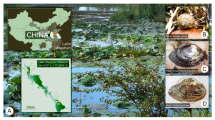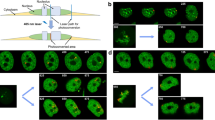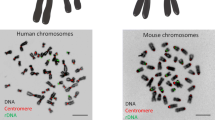Abstract
The morphology and behaviour of the holokinetic chromosomes of Tetranychus urticae Koch were studied in maturing oocytes from diplotene up to and including metaphase. Each of the three diplotene bivalents contains 2–3 chiasmata.
During congression the dyads of the axially orientated bivalents make turning movements in opposite directions till they have reached an equatorial orientation which leads to an equational first meiotic division.
It was argued that chiasmata terminalise towards both ends of the dyads and that each dyad contains two sister chromatids.
It has been supposed that the inverted meiosis of organisms with holokinetic chromosomes can be brought about by the way in which chiasmata terminalise and the kinetochores are assembled subsequently on each chromatid.
During congression vesicular strands form a Feulgen-negative zone round the bright plasm in which the bivalents are embedded. The question was raised whether these strands originate from the dense plasm surrounding each of the diplotene bivalents and bear some relation to the elimination chromatin present during the meiotic telophases.
Similar content being viewed by others
References
Bajer, A.S. & J. Molè-Bajer, (1972). Spindle dynamics and chromosome movements. Int. Rev. Cytol. Suppl. 3: 1–271.
Battaglia, E. & J.W. Boyes, (1955). Post-reductional meiosis: its mechanism and causes. Caryologia 8: 87–134.
Blauvelt, W.E. (1945). The internal morphology of the common red spider mite (Tetranychus telarius Linn.) Mem. Cornell Univ. agric. Exp. Stn 270: 1–35.
Cooper, K.W. (1939). The nuclear cytology of the grass mite, Pediculopsis graminum (Reuter), with special reference to karyomerokinesis. Chromosoma 1: 51–103.
Cooper, R.S. (1972). Experimental demonstration of holokinetic chromosomes, and of differential ‘Radiosensitivity’ during oogenesis, in the grass mite, Siteroptes graminum (Reuter). J. exp. Zool. 182: 69–94.
Dutt, M.K. (1968). Increase of the amount of DNA-Feulgen in mammalian tissue by Schiff reagents at less acid pH. Experientia 24: 615–616.
Feiertag-Koppen, C.C.M. (1976). Cytological studies of the two-spotted spider mite Tetranychus urticae Koch (Tetranychidae, Trombidiformes). 1. Meiosis in eggs. Genetica 46: 445–456.
helle, W. & A.Q.van Zon, (1970). Linkage studies in the pacifie spider mite Tetranychus pacificus II. Genes for white eye, lemon and flamingo. Entomologia exp. appl. 13: 300–306.
Hughes-Schrader, S. (1948). Cytology of coccids (Coccoidea-Homoptera). Adv. Genet. 12: 127–203.
Hughes-Schrader, S. (1947a). The ‘pre-metaphase stretch’ and kinetochore orientation in phasmids. Chromosoma 3: 1–21.
John, B. & K.R. Lewis, (1965). The meiotic system. Protoplasmatologia. VI f I. Springer, Vienna & New York.
Langenscheidt, M. (1973). Zur Wirkungsweise von Sterilität erzeugenden Stoffen bei Tetranychus urticae Koch (Acari, Tetranychydaa). Z. angew. Ent. 73: 103–106.
Luykx, P. (1970). Cellular mechanisms of chromosome distribution. Int. Rev. Cytol. Suppl. 2. pp. 1–173. Academic Press, New York-London.
Malheiros, N., D. Castro & A. Camara, (1947). Chromosomas sem centromero localizado. O case de Luzula purpurea Link. Agronomia lusit. 9: 51–74.
Nicklas, R.B. & C.A. Staehly (1967). Chromosome micromanipulation 1. The mechanics of chromosome attachment to the spindle. Chromosoma 21: 1–16.
Nordenskiöld, H. (1962). Studies of meiosis in Luzula purpurea. Heredity 48: 503–509.
Rickards, G.K. (1965). An analysis of co-orientation in mitosis and meiosis. J. theor. Biol. 9: 332–349.
Ris, H. & R. Kleinfeld, (1952). Cytochemical studies on the chromatin elimination in Solenobia (Lepidoptera). Chromosoma 5: 363–371.
Romeis, B. (1968). Mikroskopische Technik. Oldenburg, München.
Seiler, J. (1914). Das Verhaiten der Geschlochtschromosomen bei Lepidopteren. Arch. Zellforsch. 13: 159–269.
Sorsa, M. & E. Suomalainen (1975). Electron microscopy of chromatin elimination in Cidaria (Lepidoptera). Hereditas 80: 35–40.
Author information
Authors and Affiliations
Additional information
This investigation was supported by research grants from the Ministry of Public Health and Environment and from the Netherlands Organization for the Advancement of Pure Research (Z.W.O.).
Rights and permissions
About this article
Cite this article
Feiertag-Koppen, C.C.M. Cytological studies of the two-spotted spider mite Tetranychus urticae Koch (tetranychidae, trombidiformes) II. Meiosis in growing oocytes. Genetica 54, 173–180 (1980). https://doi.org/10.1007/BF00055988
Issue Date:
DOI: https://doi.org/10.1007/BF00055988




